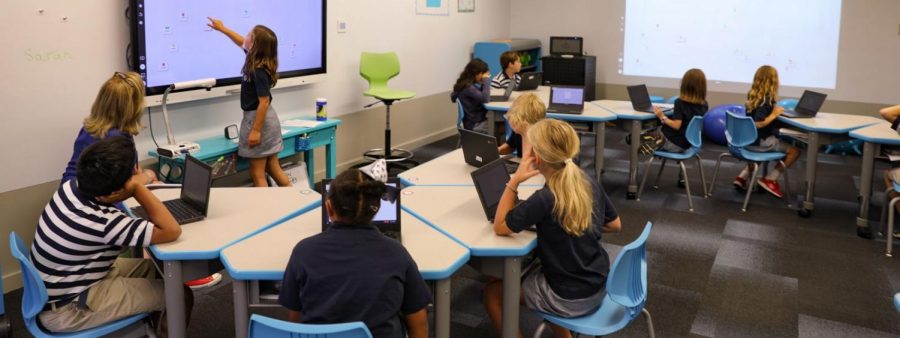I2: A New Movement at St. Andrew’s
October 31, 2019
At the end of high school, you will have spent 19,008 hours in class. Should those hours be spent sitting in that same old boring chair, learning material in the same old boring way? Learning is more than memorizing the periodic table; it is more than being lectured about about the rise and fall of the Roman empire. Education must be an experience that inspires students to be curious.
“Innovation is something that we have been doing since SA was founded,” North Campus Technology Integration Specialist Megan Whitacre said. “We were the first to have foreign languages and a global program. There are so many teachers at this school who have already come up with their own way to make their teaching innovative and the best experience possible for their students.”
Nevertheless, there is always room for improvement. St. Andrew’s school vision includes enhancing the learning experience and taking it to the next level.
Throughout the past year, groups of teachers researched, attended conferences, and visited other leading schools in the southeast to ensure that our school continues to exceed set standards for independent schools.
The taskforce concluded that most classrooms are built for lecturing, not active learning. Informed by this realization, St. Andrew’s has introduced “i2: inspire and innovate”, consisting of three major branches: i2 team, i2 labs, and i2 classrooms.
The behind-the-scenes i2 team has been working on many of the improvements we have recently seen at St. Andrew’s.
“Teachers and administrators in the team help all of us grow, help faculty implement new ways of teaching, consider new possibilities for technology, and collect feedback from the teachers and students in our i2 classrooms,” Head of School Tom Sheppard said. “This effort is a perfect compliment to a new professional growth program which we implemented for faculty this year”
I2 classrooms are not the only places where faculty can enhance learning; i2 labs are also incubator spaces for new teaching techniques.
“The i2 labs are spaces where faculty can come for support as they consider new ideas in their teaching,” Sheppard said, “Since the labs are built to mimic the classrooms, they are also spaces for us to test new technologies.”
In addition to the work the i2 team did, educational research supports all of the innovative changes in the i2 classrooms.
“[The faculty group’s] central focus was figuring out how to make both the teaching and learning experience the best possible,” Whitacre said, “What makes people most calm, serene, and allows them to focus? How can we expand the walls of the classroom beyond just our school?”
These were some of the many questions the taskforce had to think about when brainstorming the classroom plan and discovering which factors enhance students’ learning experience most.
“The i2 classrooms are built based upon the research of the LET which considered variables such as color, light, acoustics, flexibility, mobility, technology and many others,” Head of School Tom Sheppard said, “These are all elements that research suggests increase student engagement in the learning process while also enhancing possibilities for collaboration and creativity.”
One essential characteristic of the rooms is that every wall from top to bottom is a dry-erase board.
“I really enjoy the whiteboard walls so that all my students can get up at the same time to work out problems and I can give immediate feedback,” Math Teacher Caroline Lieb said.
There is an i2 classroom in each division to test how it works with different grade levels, age groups, class sizes, and subjects. The middle school i2 classroom has wobbly stools and chairs on wheels which helps young students release their energy while still paying attention.
“Middle schoolers need to be active,” Middle School History Teacher Meriwether Truckner said, “In the i2 classroom, they are able to move around and fidget without distracting the class.”
Each classroom offers many features which improve the experience of both teachers and students. Teachers use microphones which connect to a central speaker.
“I love the microphone in the room,” Upper School Math Teacher Caroline Lieb said, “It helps me not have to raise and strain my voice and it makes everyone in the room hear me equally.”
Students appreciate the i2 classroom specifically because it increases engagement and movement while learning, rather than it being a static process.
“I really enjoy the i2 classroom because it is very bright and keeps me awake,” Sophomore Lea Packer said, “I like being able to write on the white board walls and the [Solstice AV boards] It makes class more upbeat.”
However, regardless of all the benefits the room provides, such drastic change is not always easy. The room took time to get used to, especially for teachers who have lived in their classrooms day after day for years.
“At first, I struggled with feeling at home in the room, because it seemed so stark. However, displaying student work really helped to give it a more lived-in feel,” Truckner said.
I2 has no limits. St Andrew’s commitment to innovation will continue improving teaching and learning as we explore possibilities for the future.
The future is filled with possibilities,” Sheppard said, “Our job this year is to learn, assess, and plan for that future. That’s why the feedback we are collecting from students is so important. Our community has told us they want St. Andrew’s to be a beacon for educational innovation. As we implement that vision we are are learning how that fits into our school’s culture.”




